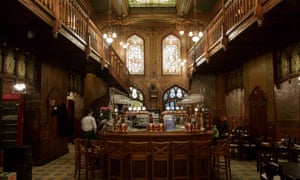 |
| Caru’ cu Bere is traditional Bucharest bar and restaurant popular with both tourists and locals. |
Though much of Romania’s capital was bulldozed by the communists, the old town survived and is abuzz with bars, cafes and restaurants
It’s fair to say that Bucharest is unlikely to win any awards for beauty or style, yet the Romanian capital surprises many first-time visitors with its cosmopolitan vibe and energy.
During the period between the wars, Bucharest’s epithet as the “Paris of the east” was accurate, up to a point. However, today’s cityscape is largely one of imposing socialist architecture, the result of former dictator Nicolae Ceauşescu’s savage redevelopment project during the 1980s – the bleakest of communist years for Romanians.
Things are much brighter these days, however, and lurking among this tangle of concrete are some wonderful art nouveau buildings (many housing terrific museums), ancient churches and monasteries, lush parkland, lakes and elegant boulevards. Bucharest’s culinary scene is at last worth getting excited about, while the city has few peers anywhere in the Balkans when it comes to nightlife.
Above all, though, the old town – also called Lipscani after the main street that crosses the area – has become the city’s go-to party place and, on any given night, you’ll find the bars full to bursting.
With the ferocious summer heat just a hazy memory, late autumn is the perfect time to explore this compelling city’s unexpected delights.
What to do and see
Bucharest’s old town was mercifully untouched by second world war bombs and Ceauşescu’s bulldozers and is the city’s most charismatic neighbourhood. Although much of the area remains agreeably tatty, a massive regeneration project has transformed many of its hitherto grubby-looking streets and buildings, the most spectacular example being the new Cărtureşti Carusel bookshop(carturesticarusel.ro) on strada Lipscani. The pint-sized Stavropoleos Church, with ornate carvings in stone and wood both inside and out, is another architectural must-see.
Whether you consider it a thing of beauty or (more likely) brute ugly, the Palace of Parliament (aka the People’s House, cdep.ro) is indisputably jaw-dropping. Constructed at Ceauşescu’s behest, its scale and opulence are head-spinning: 12 storeys (including four underground levels, one a nuclear bunker), 1,100 rooms, 4,500 chandeliers, and so on – although apparently not even 700 architects could satisfy Ceauşescu’s, or rather his wife’s, ever-changing whims. Guided tours (£5) take in a dozen or so of the largest and most extravagant rooms and conclude on the balconied terrace, affording fabulous views down bulevardul Unirii.
For more Ceauşescu-linked culture, head to the piata Revolutiei and check out the pockmarked buildings. The square was the focal point of fighting during the 1989 revolution, which led to the end of the dictator’s regime.
The National Village Museum (adults £2, seniors £1, children 50p, muzeul-satului.ro) is on the shores of lake Herăstrău and exhibits vernacular architecture from all over Romania. Comprising some 300 dwellings – churches, workshops, windmills and so on – there’s much ground to cover, so keep a keen eye out for the ingenious dug-out (or “pit”) homes from Oltenia and the iconic wooden churches from Maramureş in northern Romania.
Take a stroll around Cişmigiu Gardens, the oldest and largest park in central Bucharest. It’s a welcome dollop of green space in the city and there’s a boating lake for would-be rowers.
For a break from the noise of downtown, make your way to the enchantingMogoşoaia Palace (entry £1, palatebrancovenesti.ro), which is about 10km north-west of the centre. Designed by the 17th-century ruler of the Wallachia region, Constantin Brâncoveanu (who occasionally resided here), it’s a red-brick structure typical of the region, and the interior retains some lovely detail, not least dazzling Venetian mosaic flooring and carved wooden doors. After, it’s worth taking a walk around the grounds and woods.
Where to eat
Fine dining remains something of a novelty concept in Bucharest, but elegantly understated The Artist (13 strada Nicolae Tonitza, +40 728 318871, theartist.ro), discreetly tucked away on one of the old town’s quieter streets, is leading the way. The restaurant’s young Dutch chef creates inventive dishes such as roasted quail and crab with apricot and white chocolate (£12), and elderflower parfait with black cherries and prosecco (£5); and if choosing between the dishes proves impossible, have a cheeky bash at the spoon-tasting menu (£12), for a little taste of everything.
Home-style cooking doesn’t come much better than at Beca’s Kitchen (80 strada Mihai Eminescu, +40 744 344 700, becaskitchen.ro), a little family-run restaurant on an unassuming residential street, a short walk north of the city centre. Dishes – around half a dozen starters and a similar number of mains – are chalked up on a blackboard, which Beca herself will bring to the table and delight in explaining. There’s nothing particularly fussy or complicated about the food – for example, baked seabass with roasted veg and beetroot (£10), or rhubarb tart with vanilla sauce (£3) – it’s the simplicity, much like the place itself, that makes it a winner.
The location isn’t the most exciting but that shouldn’t dissuade anyone from venturing to Pukka Tukka (13 piaţa Amzei 13, +40 733 145034, pukkafood.ro), a super organic food bar. Try a cooked “Pukka Tukka” breakfast (£6), or a lunch of salmon with baby spinach (£8). All the drinks, including coffee, fresh apple juice and a selection of local wines, are 100% organic, too. The wicker-walled interior features barely half a dozen small tables, each with stools made from cork, but there is a pleasantly shaded patio for alfresco eating.
Caru’ cu Bere (5 strada Stavropoleos, +40 213 137560, carucubere.ro), literally “beer cart”, is the first restaurant many tourists make a beeline for but it’s also where the locals go, which says much about its authenticity. Chic waiting staff scuttle around the ornate restaurant, doling out Romanian standards such asmittitei (grilled spiced sausages, £3) and tochitură (pork stew, £7), while the house musicians belt out Romanian folk tunes. Great fun.
Where to drink
Old town cafés are ten-a-penny, but bright and buzzy Cremeria Emilia (38 strada Franceză, facebook.com/cremeriaemilia) knocks spots off all of them. The all-white interior looks fab but, on a sunny day, sitting at one of its pavement tables is the thing to do. The menu lists an irresistible selection of ice-creams, and enticing bowls of semifreddo and panna cotta, all of which are freshly made on the premises. The coffee’s not bad, either.
Romanian wine remains something of a mystery to outsiders, so Abel’s Wine Bar(10 strada Nicolae Tonitza, abelswinebar.ro) – one of several to have emerged recently – is just the spot to begin your education by sampling the many varieties of wine, most of which are available by the glass.
Of all the old town bars in which to while away the night, Bordello (9 strada Şelari, bordellos.ro) stands out. Packed most nights, it’s a bit of an all-rounder, variously staging live music, cabaret, burlesque and quiz nights. Most people, though, are happy just to tuck into a plate of tapas (from £2) and a good old-fashioned pint (from £3).
Lots of coffee houses have opened recently but Origo (9 strada Lipscani,origocoffee.ro) is the one to aim for. It’s a small, easy-going joint run by an enthusiastic team of baristas who really know their beans; be it a cappuccino, ristretto or lungo, the quality is consistently high and the service impeccable. At dusk, the venue morphs into a brilliant cocktail-cum-wine bar.
Where to stay
Dating from 1914, the Athenee Palace Hilton (doubles from £250,hiltonbucharest.com) was formerly a hotbed of conspiracy and espionage – in short, the sort of place you’d expect James Bond to stay. It’s infinitely more refined these days, though no less glamorous, with its magnificent marble lobby and luxury rooms. Facilities include a gym, spa and basement pool and the hotel’s English Bar is one of the most sophisticated – and expensive – rendezvous points in the city.
Tucked away on a sleepy residential street, Hotel Christina (doubles from £79,hotelchristina.ro) looks rather anonymous but it’s genuinely something a little bit special. The solar-panelled roof gives you some idea of the hotel’s orientation: its eco-driven ethos extends to its rooms, which come in four fetching colour schemes: pink, yellow, lilac and grape-green. There are ergonomically designed beds and LED strip lighting, and forget paper – menus are presented on iPads. Oh, and it’s got free bike hire.
Bucharest is short on decent guesthouses, but the charming Flowers B&B (doubles £35, flowersbb.ro) is an exception. It’s in a tranquil spot, 20 minute’s walk from the city centre, and its 22 rooms are painted in warm, peachy tones. In warmer weather, breakfast is served on its shady terrace.
At the lower end of the scale, arty Umbrella Hostel (dorm beds from £10,umbrella hostel.com), occupying a beautiful early 20th-century house, offers a mix of four- and eight-bed rooms, alongside a couple of doubles, all with handcrafted wooden beds, individual lockers and reading lights; shower facilities are shared. Although breakfast isn’t provided, there’s a large kitchen for guests to use, and the shady courtyard is a lovely spot to kick back with a beer.
By Norm Longley, www.theguardian.com
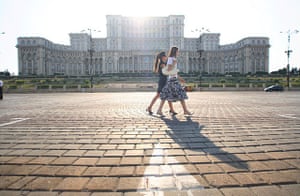
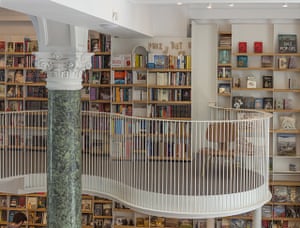
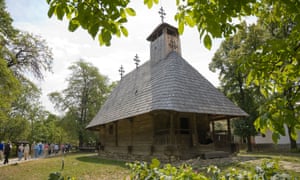
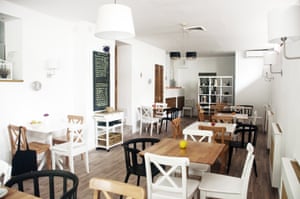

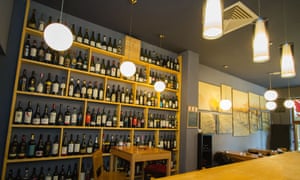

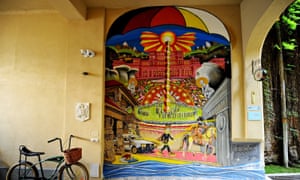
No comments:
Post a Comment